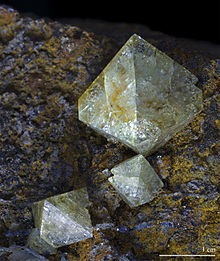Wardite is a hydrous sodium aluminium phosphate hydroxide mineral with formula: NaAl3(PO4)2(OH)4·2(H2O). Wardite is of interest for its rare crystallography. It crystallizes in the tetragonal trapezohedral class and is one of only a few minerals in that class. Wardite forms vitreous green to bluish green to white to colorless crystals, with pyramidal {102} or {114} faces and with {001} usually present masses. Also appears as fibrous encrustations. It has a Mohs hardness of 5 and a specific gravity of 2.81–2.87.[5]
| Wardite | |
|---|---|
 Wardite from Rapid Creek – Yukon, Canada | |
| General | |
| Category | Phosphate minerals |
| Formula (repeating unit) | NaAl3(PO4)2(OH)4·2(H2O) |
| IMA symbol | Wd[1] |
| Strunz classification | 8.DL.10 |
| Crystal system | Tetragonal |
| Crystal class | Trapezohedral (422) H-M symbol: (4 2 2) |
| Space group | P41212 |
| Unit cell | a = 7.03(1), c = 19.04(1) Å; Z = 4 |
| Identification | |
| Color | White, colorless, pale green, blue-green, yellow-green, pale yellow, yellow pink. |
| Crystal habit | Dipyramidal pseudo-octahedral crystals, striated; radial, fibrous, encrustations |
| Cleavage | Perfect on {001} |
| Mohs scale hardness | 5 |
| Luster | Vitreous |
| Diaphaneity | Transparent to opaque |
| Specific gravity | 2.81–2.87 |
| Optical properties | Uniaxial (+) |
| Refractive index | nω = 1.586 – 1.594 nε = 1.595 – 1.604 |
| Birefringence | δ = 0.009 |
| 2V angle | 0.0 |
| References | [2][3][4] |
Wardite was named for Henry Augustus Ward (1834–1906) of the University of Rochester in New York. It first described in 1896 for an occurrence in Clay Canyon, Fairfield, Utah County, Utah, US.
Occurrence
editIt occurs with variscite in phosphate nodules and occurs uncommonly in pegmatites and phosphate deposits through alteration of amblygonite.
Wardite is a rare mineral, which has been found in approximately 70 locations worldwide, but generally on a microscopic scale, with only a few occurrences of significant specimens.[6] The finest specimens, boasting crystals up to 4 cm in size, originate from Rapid Creek and the Big Fish River in the Dawson mining district, Alaska (USA).[7] Good quality specimens, measuring up to 1 cm, have also been discovered in Lavra da Ilha, Taquaral, Itinga, Minas Gerais, Brazil. In Spain, it appears in the form of crystals up to 1 cm found in cavities within montebrasite at the Tita mine in Golpejas, Salamanca.[8]
See also
editReferences
edit- ^ Warr, L.N. (2021). "IMA–CNMNC approved mineral symbols". Mineralogical Magazine. 85 (3): 291–320. Bibcode:2021MinM...85..291W. doi:10.1180/mgm.2021.43. S2CID 235729616.
- ^ Handbook of Mineralogy
- ^ Mindat.org
- ^ Webmineral data
- ^ Gaines, R.V., W. Skinner, C.W., Foord, E.E., Mason, B. Rosenzweig, A. (1997). Dana's new mineralogy. New York, US: John Wiley & Sons, Inc. p. 905. ISBN 9780471193104.
{{cite book}}: CS1 maint: multiple names: authors list (link) - ^ "Wardite. Mindat".
- ^ Robinson, G. W., Van Velthuizen, J, Ansell, H. G. y Sturman, B.D. "Mineralogy of the Rapid Creek and Big Fish River Area, Yukon Territory". The Mineralogical Record. 23: 1–47.
{{cite journal}}: CS1 maint: multiple names: authors list (link) - ^ Calvo, Miguel (2015). Minerales y Minas de España. Vol. VII. Fosfatos, Arseniatos y Vanadatos [Minerals and Mines of Spain. Vol. VII. Phosphates, Arsenates and Vanadates] (in Spanish). Madrid, Spain: Escuela Técnica Superior de Ingenieros de Minas de Madrid. Fundación Gómez Pardo. p. 385.